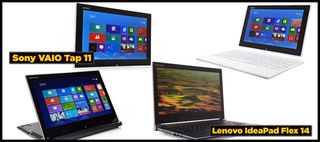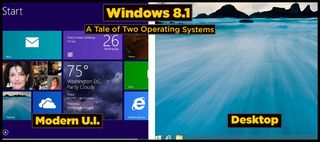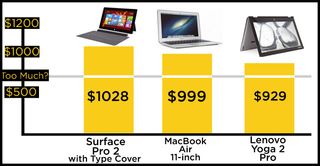Why 2-in-1 Laptop-Tablet Hybrids Are Flopping

It’s time for a wake-up call for PC makers trying to combine laptops and tablets in a single device. The experiment is kind of a bust thus far. The problems are many, including design, price, software and sheer practicality. The good news is that more devices are debuting with longer battery life (thanks to Intel’s Haswell and lower-cost Bay Trail chips). However, although many are hoping they will, I’m not convinced these devices will save the PC. Here’s why.
1. There’s No Ideal Size
As someone who uses a 13-inch notebook on the go, I find that this size offers the ideal balance of portability and screen real estate. Tablets with this display size don’t make a lot of sense, though. Take the Toshiba Click, a 13-inch detachable powered by an AMD processor. The slate portion alone weighs 2.2 lbs. (compared with 1 lb. for the iPad Air) and altogether, the hybrid weighs 4.8 lbs. That’s heavy not only for a tablet, but for a 13-inch laptop.
More: Top 10 Ultrabooks
At the other extreme, you have 2-in-1s like the ASUS Transformer Book T100. Starting at just $399, this Bay Trail device wowed us with its long battery life. However, the 10-inch screen means there’s not much room for the keyboard, resulting in a netbook-like typing experience. That size won't fly for most shoppers, who have been conditioned to purchase 15-inch notebooks. "For the mainstream consumer, the biggest challenge is just that 2-1 products are too small." said Stephen Baker, vice president of industry analysis at NPD group. "U.S. PC consumers are used to big screens."
I’d like to see more 11-inch detachable designs that are lightweight but allow for a roomier keyboard, but even then, this size isn’t ideal for productivity.
2. More Modes, More Problems

Between detachables, convertibles and sliders, there’s no shortage of design choice when it comes to 2-in-1 laptops. But right now, there are more failed experiments in the category than success stories. Take the Sony Tap 11. Although the keyboard magnetically attaches to the slate portion of the device for easy travel, you can’t attach it while typing. Instead, you either have to use the Bluetooth keyboard separately on the desk or in your lap. In other words, you couldn’t comfortably use the entire device in your lap, which I need to do every day on the bus.
More: Top 10 Tablets
Stay in the know with Laptop Mag
Get our in-depth reviews, helpful tips, great deals, and the biggest news stories delivered to your inbox.
Then you have half-hearted attempts to bridge the gap between notebooks and tablets like the IdeaPad Flex. Lenovo calls this contraption a convertible, but it merely goes from laptop to stand mode. What’s the point?
3. Windows 8.1 Doesn't Go Far Enough

As much as I like the enhancements in Windows 8.1 — including the improved Snap feature for viewing multiple open apps and much more robust search — it still feels like two operating systems are competing for the same space. You’ll still find two separate browsers and two settings menus (although the Modern one has more in it than last time).
More: 8.1 Problems Windows 8.1 Doesn't Fix
Also, there’s still no proper Start menu. Yes, you can download a third-party alternative, but why should you have to? Also, it’s utterly baffling that Windows 8.1 still hides critical info like remaining battery life in Modern Mode. Did I also mention that Windows 8 lacks a good 75 percent of apps available for the iPad and Android tablets?
4. Price is Out of Whack

If you ask Microsoft, the new Surface Pro 2 is the ultimate Ultrabook. The starting price of $899 doesn’t seem too shabby given that you’re getting a fast Haswell processor, a gorgeous 1080p display and much improved battery life versus its predecessor. But if you add a Type Cover for $129 (no, the Touch Cover doesn’t count as a real keyboard), you have a total of $1,028. And that’s just for the 64GB configuration. A 128GB model including keyboard costs $1,128. Meanwhile, the 11-inch MacBook Air starts at $999 for 128GB and the 13-inch goes for $1,099.
More: Laptop Buying Guide: 8 Essential Tips
There are some relatively affordable yet powerful Ultrabook hybrids out there, including the Yoga 2 Pro. More of a laptop first and tablet second, this device delivers a lot for its $929 starting price, including a QHD+ display and a peppy Haswell processor. However, given that you can pick up an Ultrabook from Lenovo in the U430 touch with a 4th-generation Intel CPU for just $679, you have to wonder whether it’s worth picking up a separate Ultrabook and tablet. Meanwhile, the average laptop selling price (according to NPD) is $468.
Can the 2-in-1 Fly?
The biggest issue I have with 2-in-1 hybrids is that they don’t seem to make your life any easier. Too many of the designs are too clunky and awkward, and you’re forced to use software that’s not truly optimized for desktop or tablet mode. Even the very best 2-in-1s involve some trade-offs. The ASUS Transformer Book T100 offers epic battery life for just $399, but it's more of a companion device than laptop replacement, and the Dell XPS 13 is a better notebook than it is a tablet.
With better focus, smarter software and sleeker detachable designs, PC makers can forge 2-in-1s that feel more like killer combos instead of crippling compromises. But right now, this category feels like 1 plus 1 equals 1.5.
